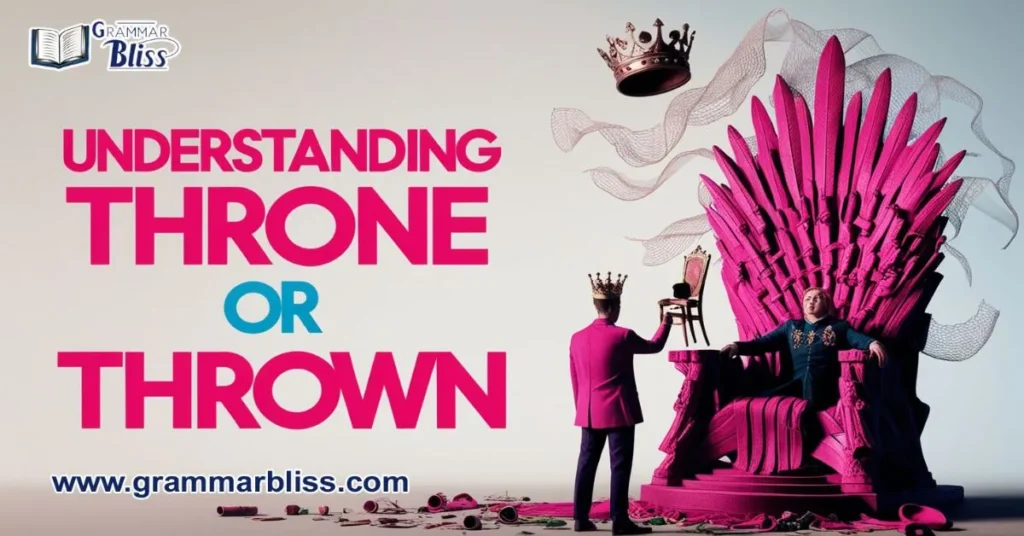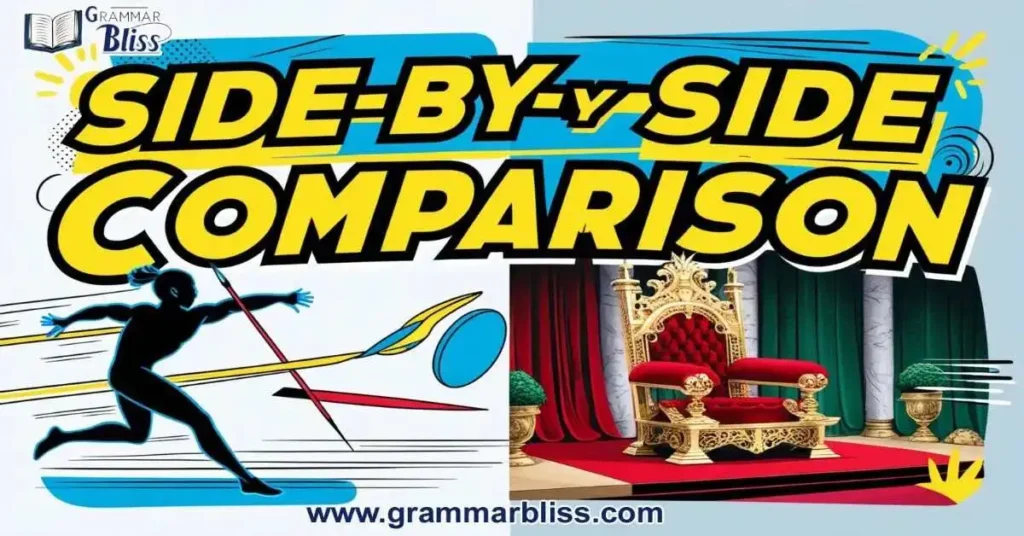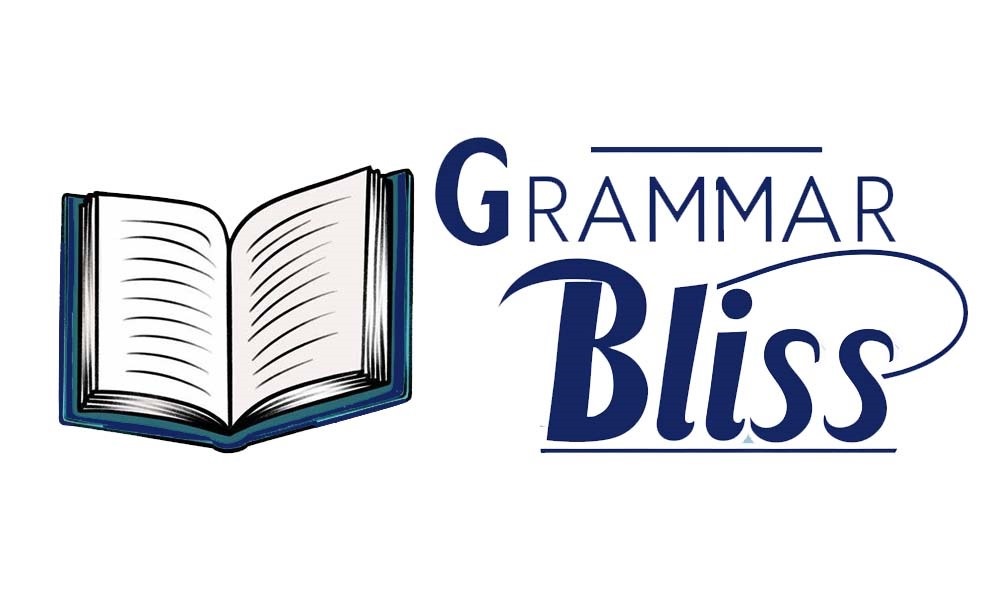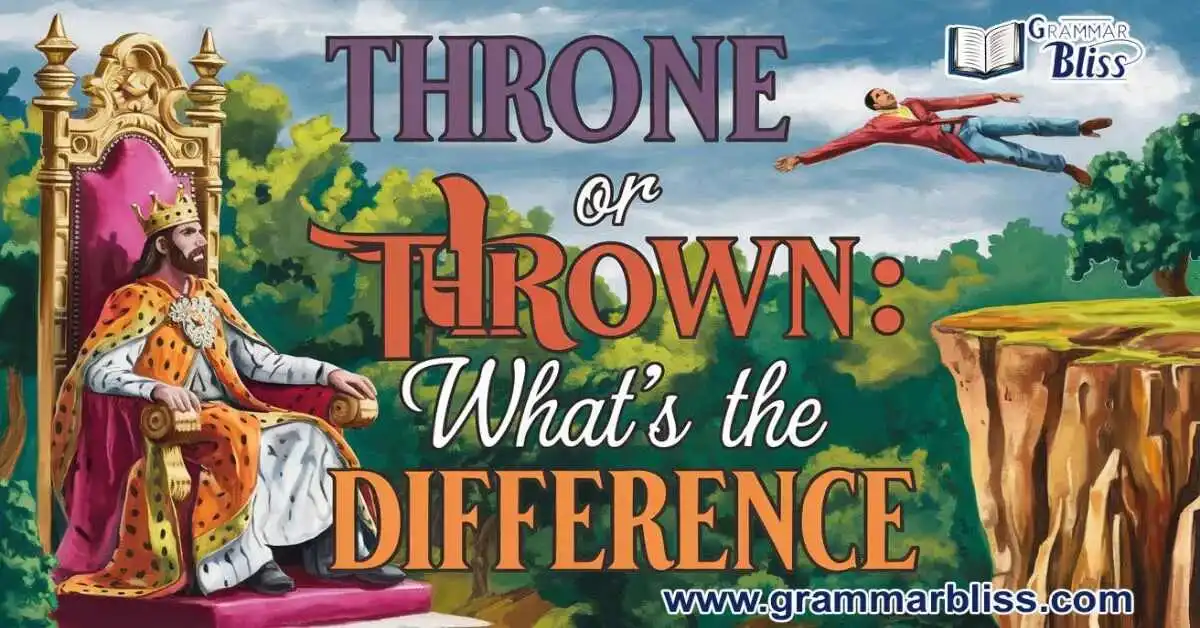The English language is full of homophones, words that sound alike but have different meanings, and Throne or Thrown is one such pair that can confuse many writers. While these words may sound the same, they have distinct meanings and uses.
A throne refers to a ceremonial chair used by a monarch, representing royalty and authority. In contrast, thrown is the past participle of throw, meaning to propel something with force. Understanding the difference between Throne or Thrown is key to avoiding common mistakes in writing and speech. This guide will help clarify their meanings and proper usage.
Quick Summary
To quickly clear up the confusion between throne and thrown, here’s a simple breakdown of each word:
- Throne: A ceremonial chair typically used by a monarch or ruler as a symbol of authority and power. It is often found in the throne room or during significant ceremonies like a coronation.
- Thrown: The past participle of the verb throw, which means to propel something with force, causing it to move through the air. This can be used in various contexts, from sports like baseball to figures of speech like “thrown into chaos.”
These two words may sound alike, but they have completely different meanings and are used in different contexts.
Read: flavor-vs-flavour-understanding-the-key-differences/
Understanding Throne Or Thrown

Both Throne and Thrown are commonly misunderstood because of their similar pronunciation. While they are not interchangeable, they are homophones—words that sound the same but have different meanings. Understanding their differences can significantly enhance your writing. Moreover, it can help you avoid embarrassing mistakes in both your speech and writing. As a result, recognizing these distinctions is crucial for improving clarity and communication.
The Role of Context
The most important thing to remember when distinguishing between these two words is that context will guide you toward the right choice. Throne refers to a physical object or a symbol of power, often tied to royalty and monarchical systems. On the other hand, thrown refers to an action of propelling something, whether it’s a ball in a sports game or a person being displaced in an unexpected situation.
Historical Significance
The throne has played an important role throughout history, representing royalty and authority. For instance, the British royal throne, such as St. Edward’s Throne, is used during the coronation of the monarch. The Peacock Throne of the Mughal emperors in Persia was an extraordinary piece, encrusted with gold and gems. These thrones were not just chairs; they were symbols of the ruler’s power and dominance over their kingdom or empire.
Throne: Definition and Usage
A throne is a royal seat, a symbol of power, authority, and leadership. It is often associated with kings, queens, and emperors. Thrones are most commonly found in the context of royalty and monarchical systems, where the throne serves as a physical reminder of the ruler’s control over their domain.
For example, when someone says, “He rose to the throne of power,” they are referring to gaining leadership in any domain, not necessarily a king’s seat. The throne room, where the throne is placed, is often seen as the center of power in a kingdom or empire.
Figurative Language
The word throne can also be used in figurative language. When we say a person has “taken the throne,” it’s not necessarily a reference to a physical throne; it could mean that someone has assumed a leadership role or position of power. The symbolism of the throne carries the idea of dominance and control, even outside of a royal context.
5 Synonyms for Throne
To better understand throne, here are five synonyms that highlight its significance and meaning:
- Royal seat: A seat used by a monarch or ruler to signify their authority.
- Monarch’s chair: A special chair for a king or queen, often used during important ceremonies.
- Imperial seat: The throne of an emperor, symbolizing imperial power.
- Regal throne: A throne that conveys the majestic and royal nature of a monarch.
- Ceremonial chair: A chair used in formal events or ceremonies, usually associated with royalty.
Learn: aerial-or-arial-whats-the-difference-and-why-does-it-matter/
Thrown: Definition and Usage
The word thrown is the past participle of the verb throw. It describes the action of propelling something with force. Thrown can describe a physical action, such as a ball being tossed, hurled, or flung during a sports game like baseball. It can also be used in figurative contexts, like someone being thrown into chaos, meaning they were suddenly placed into a challenging or chaotic situation.
Thrown is also used to describe the displacement of objects or people. For instance, when a ball is thrown during a baseball game, the movement of the ball can be described as a high-speed throw or strategic action. This kind of displacement can be sudden and powerful, just like the force behind a thrown object.
5 Synonyms for Thrown
Here are five synonyms for thrown, each emphasizing the force and action behind the movement:
- Tossed: Gently propelled with less force.
- Hurled: A more powerful throw of something, often used for emotional intensity.
- Flung: A dramatic throw, often used in the context of desperation or violence.
- Launched: Propelled with high speed, often used in the context of sports or projectiles.
- Propelled: A general term used when something is moved forward by force.
Side-by-Side Comparison

| Feature | Throne | Thrown |
| Meaning | A ceremonial seat for a monarch or ruler | The past participle of throw |
| Part of Speech | Noun | Verb (past participle) |
| Context | Royalty, symbol of power, leadership | Action, force, displacement |
| Example | “The king ascended to the throne.” | “The ball was thrown across the field.” |
Everyday Usage Examples
Here are some examples to help clarify how throne and thrown are used in everyday language:
Throne Examples
“The king sat on his throne during the coronation ceremony.”
“The throne symbolizes royal authority and the power of the monarch.”
“After years of hard work, she finally claimed the throne of the company.”
Thrown Examples
“The baseball was thrown with incredible speed, reaching the catcher in seconds.”
“He was thrown into a leadership role unexpectedly, but he handled it well.”
“The rock was thrown into the river, causing a splash.”
Explore: say-your-peace-vs-say-your-piece-understanding-the-difference/
FAQs: Throne Or Thrown
What does the word “throne” refer to?
Throne refers to a ceremonial chair used by a monarch or ruler as a symbol of authority.
What does “thrown” mean?
Thrown is the past participle of throw, meaning to propel something with force.
Can “thrown” be used to describe a royal seat?
No, thrown refers to an action, not a royal seat like a throne.
Is “throne” ever used figuratively?
Yes, throne can symbolize power or leadership in a figurative sense, like “rising to the throne of power.”
What is the key difference between “throne” and “thrown”?
Throne is a ceremonial chair for a monarch, while thrown describes an action of propelling something with force.
Conclusion
Understanding the difference between “Throne” or “Thrown” is essential for clear communication. In fact, recognizing this distinction ensures accuracy and prevents confusion in both spoken and written language. . A throne symbolizes royalty, authority, and leadership, while thrown describes the action of propelling something with force. By recognizing the distinctions between these two homophones, you can avoid common mistakes in both writing and speaking. Whether you’re discussing royal power or a sports action, using the right word ensures your message is clear and accurate. Remember, a king sits on a throne, but objects are thrown through the air.

